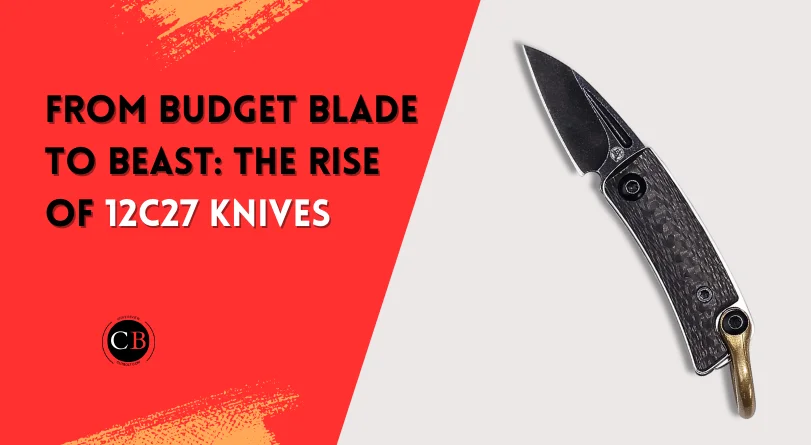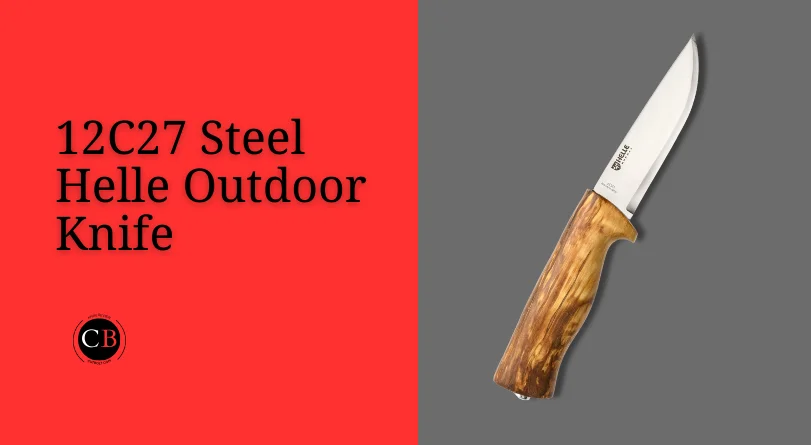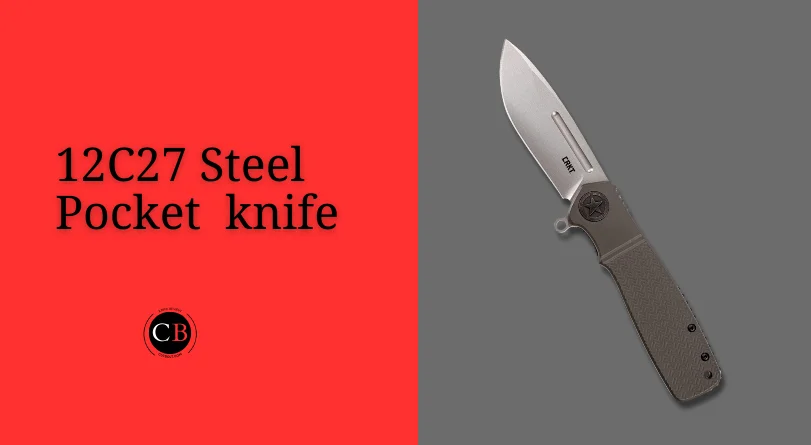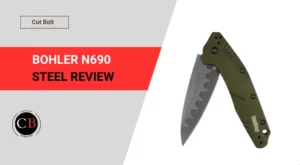If you’re interested in knives, especially custom knives, you’ve probably heard of Sandvik 12C27 steel. But is 12C27 a good knife steel?
Chances are you’re reading this because you want to know more about this steel. Well, it happened to me once too, and that’s why I did some research and compiled the information I could find on Sandvik 12C27 steel into this post.
- What is Sandvik 12C27 steel?
- Chemical composition of Sandvik 12C27 steel
- Is 12C27 stainless steel or is it rust-free?
- What is the hardness (HRC) of Sandvik 12C27 steel?
- Properties of Sandvik 12C27 steel
- Is 12C27 a good knife steel?
- Sandvik 12C27 steel equivalents
- 12C27 steel comparison with similar steels
- How to care for 12c27 steel knives?
- Final Verdict: Is 12C27 a good knife steel?
Key Takeaways
- The secrets of 12C27’s impressive toughness and edge retention
- Why it’s a favorite among outdoor enthusiasts and professional chefs alike
- How it holds up against pricier steel options (spoiler alert: you might be surprised!)
- Tips for keeping your 12C27 blade razor-sharp and ready for action
What is Sandvik 12C27 steel?
Sandvik 12C27 steel is a low-end stainless martensitic chromium steel produced in Sweden that is optimized for knives. It is generally found in high-end chef’s knives, pocket knives, hunting knives and tactical knives but also in ice drills and skate blades.

Chemical composition of Sandvik 12C27 steel
Understanding the composition of Sandvik 12C27 steel is key to understanding its performance. The following table provides an overview of the key elements:
| Element | Portion | Effect |
| Chrome | 13.5% | Improves wear resistance, heat resistance and scale resistance. It increases tensile strength because it acts as a carbide former. Use of rust-proof or stainless steel, as it increases corrosion resistance from a mass proportion of 12.2%. Reduction in weldability. |
| Carbon | 0.60% | Increasing hardness and tensile strength. In larger quantities, increase in brittleness and reduction in forgeability and weldability. |
| Manganese | 0.40% | Improves hardness and tensile strength. |
| Phosphor | 0.025% | Increases tensile strength, hardness and corrosion resistance but also brittleness. |
| Sulfur | 0.010% | Increases machinability but also brittleness. |
| Silicon | 0.40% | Improves strength. |
A chromium content of more than 12% makes Sandvik 12C27 steel a stainless steel by definition. In addition, with a carbon content of 0.6%, it is slightly higher compared to lower-end steels.
Is 12C27 stainless steel or is it rust-free?
The world of steel can be confusing, especially when it comes to terms like “stainless” and “rust-free.” While they might seem interchangeable, there’s a subtle difference that can impact your knife performance and maintenance. Let’s dive in and separate fact from fiction!
Stainless steel: A balancing act
Imagine a tightrope walker balancing on a thin line. On one side, you have the desire for a steel that resists corrosion and staining (like ketchup on your favorite knife). On the other, you want a material that’s strong and retains its edge well. That’s the essence of stainless steel.
To achieve this balance, stainless steel must have a specific composition. The key ingredient? Chromium! This magical element acts like a shield, forming a protective layer that prevents rust and stains. But there’s a catch: the chromium content needs to be just right.

The Chromium Threshold: Stepping into rust-free territory
Think of chromium content as a ladder leading to rust-free paradise. Every step up (meaning more chromium) increases your steel’s resistance to corrosion. But to reach the top, you need at least 10.5% to 13% chromium, depending on the specific definition.
12C27: A Champion of both worlds
Now, let’s talk about our hero, 12C27 steel. This Swedish wonder boasts a 12% chromium content, placing it firmly in the rust-free zone. But it doesn’t stop there! 12C27 also keeps its “stainless” title by keeping its sulfur and phosphorus content below 0.025%. It’s like a double win for your knife!
The Takeaway: Choose Wisely, Sharpen Often
Understanding the difference between stainless and rust-free steel empowers you to make informed choices. Remember, even with its impressive credentials, 12C27 (and any steel) can still rust if neglected. Proper care and regular sharpening are essential to keep your blade gleaming and performing at its best.
So, the next time you’re browsing for a knife, remember: stainless and rust-free are not the same, but 12C27 is a champion of both! Choose wisely, sharpen often, and enjoy the satisfaction of a well-maintained blade that can handle anything you throw at it.
What is the hardness (HRC) of Sandvik 12C27 steel?
According to Sandvik, the hardness of 12C27 is in the range of 54-61 HRC, depending on the method of heat treatment. If it is hardened in the upper range, this gives the steel a high cutting durability and at the same time increases its wear resistance.

Properties of Sandvik 12C27 steel
According to the chemical composition and hardness of Sandvik 12C27 steel, it offers the following properties and characteristics:
- Edge retention: With an average HRC of 56-58 HRC and a good percentage of carbon, 12C27 steel offers excellent edge retention for a knife.
- Corrosion Resistance: 13.5% chromium provides 12C27 steel with high corrosion resistance. So if you use it in a knife steel, you will get a knife that is great for hunting or fishing.
- Wear resistance: 0.6% carbon with a small amount of phosphorus gives the steel high strength and high wear resistance.
- Sharpness: This Swedish steel has a great combination of hardness and toughness, resulting in a hard blade that is easy to sharpen.
- Machinability: I am not an expert on machinability; according to the manufacturing company, it is good for machinability, and at the same time the steel has sulfur, which increases machinability.
- Toughness: 12C27 has great toughness thanks to the chromium it contains.
Is 12C27 a good knife steel?
Those who have read the previous section can guess: yes, 12C27 is a good knife steel.
Since it is a low-end steel, very close to the mid-range steels, it offers good toughness, hardness, wear resistance, cutting-edge, and corrosion resistance, which are excellent characteristics for a knife.
So the answer is YES, it is a good knife steel. It is particularly well suited for all knives that are used outdoors and here then also in humid environments! It is as o a good choice for hunters, anglers, divers, survivalists and so on.

Weak points of 12C27 steel for making knives
Here are the weak points I found for 12C27 steel knives:
- Not the Sharpest Tool in the Shed: Compared to premium steels like S35VN or ZDP-189, 12C27 won’t achieve the same razor-sharpness. However, the difference is often negligible for most everyday tasks.
- Wears and Tears (a little): While tough, 12C27 may lose its edge slightly faster than high-end steels under intense use. More frequent sharpening sessions might be needed for heavy-duty enthusiasts.
Relevant: How good is 8CrMoV steel?
Sandvik 12C27 steel equivalents
Depending on hardness, chemical composition, and price, it is roughly in the range of Japanese AUS 8 steel (a medium-grade steel) and a little over 440C. All in all, these are all good steels for knives in the range of say $25 – $100 depending on the type of knife, grade of steel and materials used.
12C27 steel comparison with similar steels
How does Sandvik 12C27 compare to other popular steels used to make knives today? Let’s find out.
Sandvik 12C27 Steel vs D2
D2 is known for its exceptional edge retention and tremendous wear resistance, and has even been named the king of wear resistance by knife steel connoisseurs. The secret to D2’s high performance in these areas is its high hardness. While 12C27 also offers excellent properties in terms of edge retention and wear resistance, it does not reach the level of D2 steel.
The sharpenability of 12C27 is fairly easy and only becomes a challenge in the upper range, when you move it to that of D2 steel. In terms of machinability, 12C27 is easier to machine than D2. In addition, Sandvik 12C27 Swedish steel is cheaper to produce than D2 because it contains fewer alloying elements. In terms of cost, D2 knives are more expensive than 12C27 steel knives.
Sandvik 12C27 vs VG10 steel
VG10 is higher on the virtual steel scale than 12C27. It has a higher hardness and offers better edge retention, wear resistance and corrosion resistance than 12C27. However, unlike 12C27, it is not easy to sharpen due to its high hardness. However, VG10 is quite brittle and its edge will chip easily when it comes in contact with hard surfaces. VG10 is also more expensive.
Sandvik 12C27 steel vs CPM S30V
CPM S30V is considered a premium steel and ranks much higher on the steel scale than 12C27. S30V has the advantage of vanadium in the alloy which when combined with carbon forms what are known as vanadium carbides, which offer superior performance to the chrome carbides in 12C27 in terms of edge retention. However, 12C27 outshines this premium steel with its much easier sharpening and lower price.
Sandvik 12C27 steel vs 440C
12C27 and 440C are both pretty good and popular knife steels, but they are not without a few significant differences. 440C is less hard than 12C27 and is considered more of a soft steel. As a result, it is much easier for bladesmiths to work with. 440C also offers higher toughness than 12C27.
Although 440C has good edge retention, Sandvik Swedish steel offers even better edge retention.
On the other hand, the high chromium content in 440C (17%) gives it better anti-corrosion properties, i.e. it takes a long time and a very corrosive climate for it to rust. 440C can also be mirror polished and is readily available. Last but not least, 440C steel knives are generally less expensive than 12C27 knives.

Sandvik 12C27 vs 8Cr13MoV steel
China-made 8Cr13MoV steel is a lower-end steel, just like 12C27 steel, so this is a fair comparison. Looking at the chemical composition of 8Cr13MoV, you will notice that it contains additional compounds that are not present in 12C27 stainless steel, such as molybdenum, vanadium and nickel.
These give the steel an advantage over 12C27 in the areas of hardness, sharpness and toughness. However, this Chinese steel is not very corrosion-resistant and cannot compete with 12C27 stainless steel in this regard.
Sandvik 12C27 steel vs 420HC
12C27 and 420HC are also a great pair of blade steels with great performance. However, 420HC has a lower carbon content than 12C27, which means the Sandvik steel offers better edge retention than 420HC. However, the addition of vanadium in 420HC gives it better wear resistance.
Although both steels are easy to sharpen, 420HC is slightly easier to sharpen because it is softer and thus generally easier to work with. Both types of steel offer similar properties in terms of corrosion resistance. In addition, both are in the affordable range, making them a good choice for budget-conscious buyers.
How to care for 12c27 steel knives?
Cleaning:
- Wash after use: After using your knife, rinse it thoroughly with warm water and mild dish soap. Wipe it dry with a clean cloth to prevent rust.
- Tackle tough stains: For tougher stains, you can use a soft sponge or brush with baking soda or mild abrasive cleaner. Rinse well and dry completely afterward.
- Avoid harsh chemicals: Don’t use harsh chemicals like bleach or chlorine on your knife, as they can damage the steel and handle.
Sharpening:
- Maintain a sharp edge: While 12C27 retains its edge well, regular sharpening is crucial for optimal performance. A good rule of thumb is to sharpen your knife whenever you feel it struggling to cut through materials it used to handle effortlessly.
- Choose the right tool: You can sharpen your 12C27 knife using a whetstone, honing steel, or even a good quality knife sharpener. Each method has its pros and cons, so choose the one you’re most comfortable with.
- Maintain the angle: When sharpening, maintain the original angle of the blade for the best results. This will ensure your knife retains its cutting efficiency.
Storage:
- Keep it dry: Store your knife in a dry place where it won’t be exposed to moisture. A knife block, drawer, or sheath are all good options.
- Avoid harsh environments: Don’t store your knife in extreme temperatures or humid environments, as this can accelerate corrosion.
- Protect the blade: If you’re not using your knife for a while, consider coating the blade with a thin layer of mineral oil to prevent rust.
Final Verdict: Is 12C27 a good knife steel?
After researching I found 12C27 steel is yet unknown to many. Evaluating 12C27 as a knife steel reveals a blend of admirable qualities. 12C27 is versatile and value-packed steel that offers excellent performance for its price. It’s a perfect choice for:
- Everyday carry knives: Its rust resistance and toughness make it ideal for daily tasks and pocket companions.
- Outdoor knives: Whether camping, fishing, or hunting, 12C27 can handle the elements and perform admirably.
- First-time knife owners: This steel’s ease of sharpening and affordability make it a great entry point into the world of knives.
If you’re looking for the absolute sharpest or most wear-resistant steel, there are certainly better options available. However, if you prioritize a combination of good performance, affordability, and ease of use, 12C27 is a champion waiting to be discovered. So, don’t be fooled by its humble origins; give 12C27 a chance, and you might just find your new favorite blade.



